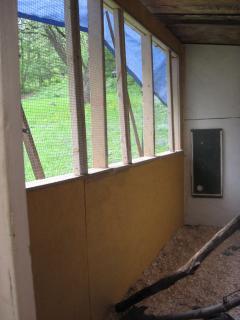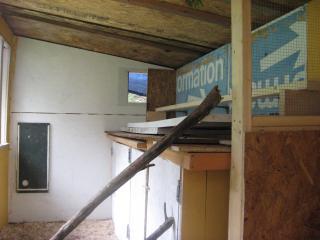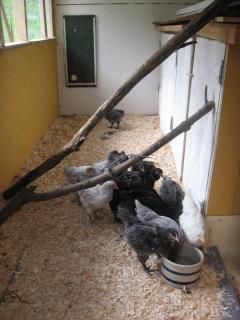I think neosporin should be fine as long as it does NOT have the painkillers in it like benzocaine or lidocaine. Those, I've read on the forum, are toxic to chickens. Hydrogen peroxide seems to be ok, too. Just use it to clean the wound this time. Using it daily on a wound is not advised. Here's a post for wound care that I bookmarked. Of course, your hens don't sound like they have really bad wounds.
threehorses wrote:
WOUND CARE FOR POULTRY by Nathalie Ross
Here's my usual way of doing wounds. It's worked for some pretty extreme wounds, including one 2x1 wound that went all the way down to the silver covering of the spine of one bird.
First, gather materials:
VetWrap or similar self-adhesive wrap.
gauze wrapping type bandages or squares (depending on what you have to bandage)
non-stick pads (depending on what you have to wrap)
antibiotic ointment (neosporin, Swat for horses if you have flies around)
hydrogen peroxide (h202)
iodine
warm water
a needleless syringe - preferably a big one like 30 cc's
suture material if you need it (this ideally should be left to a vet)
a small pair of scissors like cuticle scissors are helpful
large scissors
(duct tape in some cases)
a good safe blood clotter. I prefer Clotisol as it's not poisonous and clots IMMEDIATELY even in high blood situations. You can even use it inside of beaks. It's water based, lasts ages for a small bottle. Seriously - ages. You can pretty much only get it online, but it's a must-have for a cabinet. Once you use it, you won't go back.
q-tips
papertowels
clean clothes that can be stained
DECIDING WHETHER OR NOT TO TREAT BY YOURSELF:
First, an important note. It would be ideal if, as poultry owners faced with an injured bird, that the bird be taken to a qualified veterinarian who can not only dress the wounds, access the damage, but also prescribe the correct antibiotics and follow up as necessary. This, first and foremost, is what I recommend for any wound situation that is more than minor. Please take that to heart.
If instead you decide to treat the wound yourself, here are some basic instructions on how to do so. Note that every wound, every case, is different. Use your common sense and imagination on determining when this protocol must be flexed to fit your situation.
PREPARATION:
First, examine the bird and find all wounds. Use your big and little scissors to trim feathers away from the area. Try to only take as many as could touch the wound, no more - they need feather protection and the feathers won't grow back til next moult. Also be careful, if wing feathers are near, not to cut the living flesh part inside feather quills.
If the wounds are under the wing, sometimes you can simply wrap the wing in a t-shirt to keep whatever touches the wing clean. Baby tshirts would be great for this. Neck part at the top of the wing, fitted with a little duct tape on the cloth (not tight please) and just tie the other end of the tshirt.
Make sure to look very carefully against the skin for puncture wounds. There might not be look, and puncture wounds are tricky and hard to find. Note the location and severity of all wounds.
Cleansing:
Take your syringe and fill with H202 (straight) or h202 slightly diluted with water. Use the syringe to vigously clean the wound area including in the wounds. If the wounds are puncture wounds, use diluted water/h202, not straight. You only use h202 the first time as it tends to burn tissues and keep them from healing if you continue. But it's great for bubbling out bits of dirt from inside the wound. Do this cleansing about three times per wound.
Follow up by rinsing out the h2o2 with a water/iodine mixture made to be just the color of slightly strong iced tea. You want it warm. Fill your same syringe that you used with the h2o2 and flush the wounds rather vigorously.
At this time, if there are any pieces of flesh that need to be removed, remove them. This is where I use a q-tip dipped in a bottle-cap full of clotisol (so you don't contaminate the original bottle).
Doing this on a table that's ok to stain is best. I've done this on my truck's tail gate as I can clean it afterwards. Place a lot of papertowels under the birds for these two cleansing phases to keep the drainoff from going everywhere.
Use another clean papertowel to dry the wound. You want to leave some iodine solution inside the wound - it doesn't have to be skin-dry. Just dry enough for some ointment to stick.
DRESSING:
Once the wound is well cleaned, then you'll want to dress it. I use Neosporin and q-tips most often for this job. If there are flies in the area at all, I will use Neosporin inside the wounds (ointment) and use Swat wound ointment for horses instead. (It has fly repellent that's safe for poultry in it.) I fill punctures with neosporin. If they're deep, I stick the top of the tube into the wound (and throw away the tube after I'm done with everything). Pack it. You usually want air in a wound, but puncture wounds can sometimes heal on top first and leave a pocket inside. The antibiotic ointment (not creme) is a little insurance against too much bacteria and thus abcesses.
If the wound is one that absolutely must be stitched, then pack it with the antibiotic ointment. If you're using a flyproof ointment, wipe the wound and then use the fly-proof on top. Otherwise just wipe slightly so there's a little antibiotic ointment on the important top part of the wound. You don't want to stray too far from just the wound, keep the bird dry.
On closing wounds with sutures. Puncture wounds shouldn't be sutured. Bad bacteria love a place where there's no oxygen. Suturing closes the wound and encourages festering within. As much air as you can get to a wound, the better, except that the interior of punctures should have some antibacterial action going on.
I've had some serious wounds in my flock before. The only time I've sutured was when a very large flap of skin was torn from the front of a neck (read as 3 inches by 10 inch flap). Another recent case involves a possible rather large hole in a crop which, should it leak food, should be sutured. Otherwise try to leave things open. Poultry can regrow an amazing amount of skin back if there's muscle underneath. New skin will granulate and grow in to fill in gaps that would surprise you.
On the areas that are just uncovered, I usually use antibiotic creme (versus ointment) because it's water based. Sometimes I'll just put a thin smear of antibiotic ointment, however, if that's what I have. Or fly-preventative ointment if there are flies in the area.
DRESSING WITH BANDAGES:
If at all possible, try not to cover with bandages. The average bandage keeps air out and moisture in and not in a good way. If you must bandage (a dirt floor area, extreme fly issues, etc) then try to keep the bandage to a minimum and very airy. That's why I'm not a big fan of nonstick bandages. They tend to trap moisture and cause a very warm airless area. But sometimes you have to use them. If so, cover the wound with the bandage. Wrap twice with very gauzey gauze wrap. Then put one layer only of VetWrap over. If you must secure (to keep the bandage from falling, for example) you can use very thin strips of duct tape like you would tape a birthday present. Using as little as possible, but a very strong tape like duct tape, helps let the air in.
Sometimes I've even used just one layer of a very clean paper towel rather than use a non-stick. Afterwards, if you have to remove it, you can soak with warm water and pick the bits out if it sticks. Gauze tends to embed in wound seepage.
Think out of the box when it comes to covering areas that are wounded. With my geese who had multiple puncture and surface wounds on their chest, and a high fly area, I used one white sheet that I formed into a sort of front-bib and tied behind their back. T-shirts are also awesome to cover a bird's body. Buy the appropriate size, slip the neck over their neck, their legs through the arm holes, cut two holes through which you slip their wings. Gather the bottom end (cut so that you don't cover their vent) at the top of their back and duct-tape the cloth to make it stay fitted. T-shirts are very airy, cheap, washable, and absorbent.
SUTURES:
If your bird requires stitches, suture material with thread attached can be found at many feedstores or purchased online ahead of time. The size you want is for dogs and cats. Sutures aren't stitched like a pillow case, but each stitch is its own knot. The semi-circular needles of suture needles are ideal for going into and out of the skin. Note: stitching is not easy - skin is tough, usually the needle is slippery, and it's rather tough to do. Overestimate the amount of suture material you need as you'll make knots and cut off the excess bit sticking up.
MAINTENANCE:
Many wounds, if properly cleaned and dressed and left airy, do not need much maintenance. Oddly, one of the best ways of telling whether or not a wound is doing well is by using your nose. Smell the wound at the time of cleaning. Wounds have a particular almost sweet but not cloyingly sweet smell. Remember the smell. Then smell the wound daily to see if you smell rot. If you do, there's not enough air to the wound and possible infection going on.
Wounds will seep a little - that's natural and the body's way of dealing with wounds. Usually the seepage will be mostly clear and smell of wound. However, if there's any opaqueness to it, or clotted texture, that's infection. Also there will be some natural inflammation as the body tries to bully off the bad bacteria and bring in healing materials to the wound. However excessive inflammation, discoloration (especially black or green), should be noted.
If a wound needs cleaning or examining, take off what bandages you can gently. If they stick to the seepage from the wound, use warm water to soak the bandage parts remaining away from the drainage.
Then examine the wound, determine what needs to be done, and redress from the iodine stage onward.
ANTIBIOTICS:
Many wounds do not require additional antibiotics other than topical (on the skin) antibiotic dressings. However in the case of animal bites that weren't caught immediately, cat bites, and wounds that have been sitting or are particularly deep, it may be a good idea to treat with antibiotics. If you make this decision, please be sure to get one that is appropriate for wounds. The packages at the feedstore are not.
Penicillin G Procaine (Aqueous Pen-G) is commonly found at many feedstores in their fridge section. It's awesome to keep in your own fridge for a rainy day. It's a very thick antibiotic and requires a thicker gauge needle. I would use no thinner than a 22 gauge, preferably something more thick at a length of .75 to 1 inch. At many feedstores, you can buy 3 cc syringes that are together already with needles. These are nice to have on hand as well as that 30 cc syringe that you'll use to flush wounds.
Instructions on how to give an injection are available separately as well as how to treat with antibiotics. If you do choose to use injectable antibiotics, be prepared to go the entire recommended course. Penicillin G Procaine is a concentrated penicillin (they're not all created equally) and only is required to be given every other day. Based on the type of antibiotic you expect to use, buy that many syringes plus two.
HEALING:
Birds in healing mode need help being stabilized, nourished, and hydrated. We all know how delicate birds can be, but it's surprising how resilient they can be at times. However, wounds will often depress a bird or cause them to go into shock. A stressed or shocked bird may not be able to digest foods they're commonly given. For that reason, I recommend only giving easily dissolved feeds when a bird is in the first stages of recovery. Think crumbles, pellets, etc. You don't want to make a drastic change in their diet ever, much less when they're already stressed. If a bird is reluctant to eat, try wetting the pellets/crumbles. You can also add a boiled egg yolk (one per six cups of food) mashed into the crumbles. I like to also give probiotics (yogurt, Fastrack, Probiocs, acidophilus, or whatever I have available) during this time to combat a secondary intestinal disorder from stress and change of way of eating. Yogurt is simple. You can mix 1 tablespoon per two cups of feed.
The added protein in an egg yolk helps the bird to heal. Adding a capsule of vitamin E to that mash (one per 2 cups of mash) also helps healing. If the birds are stressy, or not able to eat normally, I'll use a vitamin/electrolyte mix in their water for the first few days. I never ever use an oral antibiotic for wound treatment. Period.
CONCLUSION:
It's unfortunately common that poultry are victims of predation and wounds. They are delicate and, with their ultra-fast metabolisms, can die readily if they decide to. Remember that an injured bird can often have internal injuries we never see. If you lose them, just remember you tried your best. However you might be surprised, with proper wound-care, how many of these birds recover to absolutely normal lives. Just be patient as healing takes a while. Usually separate the birds, but if they can be near their peers they take heart from it and will do better.
Good luck with your flock, and I hope this information has been helpful.
Nathalie Ross
(Please do not reproduce without permission of the author. The author is not a veterinarian and does not intend to dispense information that at all should replace the advice of a qualified avian vet.)
Take care,
Melissa






